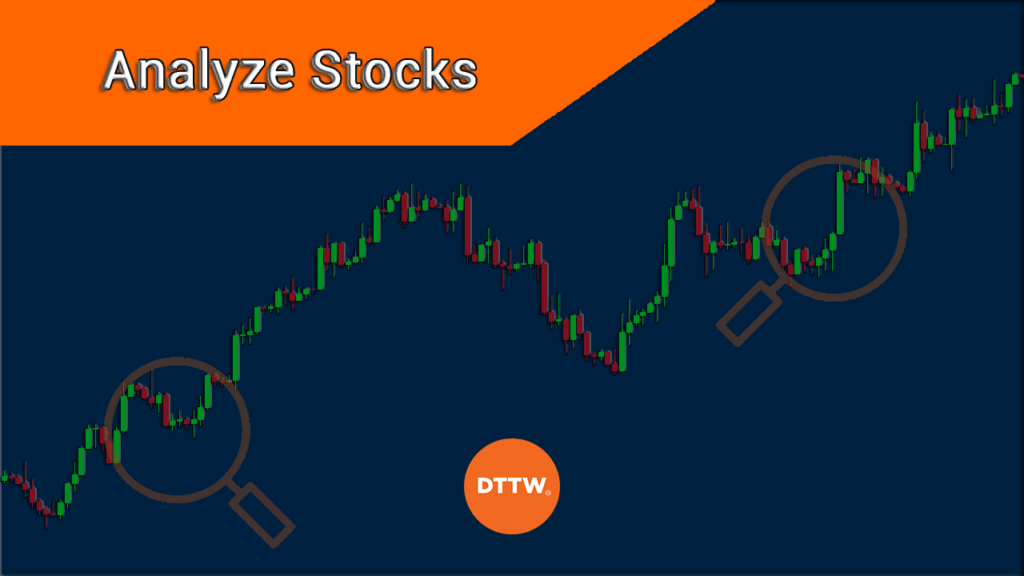With time and experience, most day traders are able to develop strategies that work for them. However, there are certain factors that all talented traders consider when they analyze stocks.
By being aware of these factors and knowing why they matter, you will have an easier time achieving ongoing success.
Table of Contents
Methods to analyze stocks
Fundamental analysis
This is the first thing to look at when analyzing a stock. It is the process of looking at key factors that will affect the intrinsic value of the shares. For example, you could look at macro factors such as interest rates and retail sales.
Also, you can look at stock valuation multiples and earnings. Some of the most popular ratios in analysis are the price to earnings (PE), price to sales (PS), and EV to EBITDA.
To be fair, most day traders use this form of fundamental analysis just for reference purposes. In most cases, they use technical and price action strategies to make decisions.
Technical analysis
This is the process of using technical indicators like moving averages and the Average Directional Index (ADX) to determine whether you should buy or sell a stock.
For day trading, we recommend that you use the concept of multi-time analysis. This is where you start your analysis by looking at the hourly chart and narrowing it to the 5-minute chart.
Price action analysis
This is a chart analysis method where you look at patterns like triangles, head and shoulders, and bullish flags and pennants. By so doing, you can identify trading opportunities in a relatively easy way.
Related » Wise Traders Should Believe in Analysis, not Forecasting
What do you need to consider?
Industry or sector
Always take the industry or sector of the stock into consideration. How are other stocks in the same sector or industry faring? This will provide clues about what you can expect.
Some of the top sectors among day traders are technology, energy, finance, and consumer staples. Tech stocks like Roku, Snap, and Okta provide the most volatility.
Related » How to conduct a SWOT analysis
Key levels
Look for key levels that can be used to make risk/reward trades. Start by noting the stock’s high and low for the day, but make sure to check for any unusual movements as well.
There are several ways of identifying key levels in stocks trading. These include:
- 52-week low or high – You can look at stocks that are hitting their 52-week low o 52-week high. You can use platforms like Investing and Yahoo Finance to find these details.
- Multi-time analysis – You can conduct a multi-timeframe analysis to find key support and resistance levels.
- Even numbers – At times, even numbers like $50 and $60 can provide excellent (psychological) entry or exit points.
- Support and resistance levels – You can use the tools that are provided to place support and resistance levels.
News
Is there some rhyme or reason as to why a stock is in play or experiencing volatility? The answer sometimes lies in the news, so find a reliable news source for the stock that you’re analyzing and use it to get a feel for the big picture.
Some of the top news sources are television channels like Bloomberg and CNBC. You can also use websites like Bloomberg, WSJ, and CNBC to find the latest news about a stock.
These news events will help you know what is moving key stocks and what to expect in the longer term. You can also subscribe to a market watchlist to find the best stocks to trade.
» Related: How to do news trading
Relative Strength
Consider how the market is performing versus how the stock is performing. Does the stock tend to follow right along with the market? Does it rally alongside it or stay put? When the market sells off, does the stock drop? Being aware of this can prove to be truly invaluable.
Trend
What kind of trend is the stock currently exhibiting? Is it on an upward trajectory or a downward one? Is it static? Don’t just consider the trend for the current day; look for trends across longer periods of time too.
Make notes of such trends, and you might be able to find trends within trends as well. Some of the top trend indicators to use are moving averages, envelopes, and parabolic SAR.
Volatility
Avail yourself of stock charts at every turn and use them to stay abreast of any volatility that’s occurring with the stock in question. When volatility happens, how long does it last? Does the stock tend to exhibit the same patterns under such circumstances?
Some of the best tools to use to find the overall volatility in the market are the CBOE Volatility Index (VIX) and the fear and greed index.
Volume
Analyze the past performance of the stock to see how many shares are typically traded in a day. How many shares have been traded today? You can get a sense for whether institutional participation is having an effect by considering the current relative volume of the stock versus its average volume.
Some popular volume indicators to use in the market are the accumulation and distribution, on-balance volume, ease of movement, and volume-weighted moving average.
» Related: Why volume matters for day traders
Summary: The keys to analyze a stock
As you grow and become more experienced as a day trader, you may pick up additional techniques along the way. Furthermore, you may find that some factors are more important to certain stocks than to others, and you can use this knowledge to make more profitable trades.
External Useful Resources
- How to Pick Stocks Using Fundamental and Technical Analysis – Schwab





